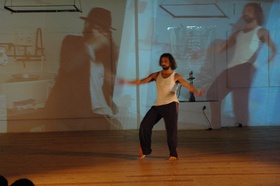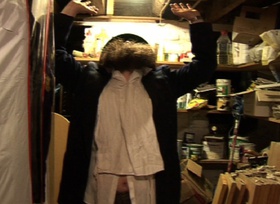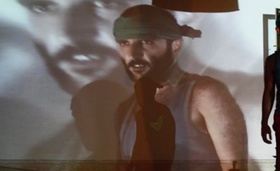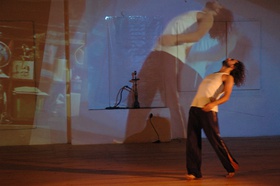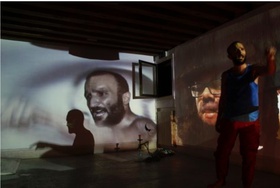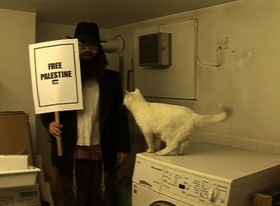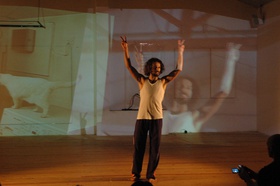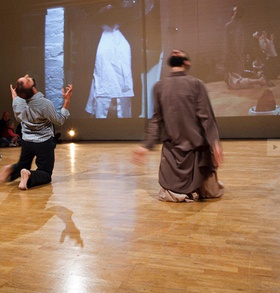Projects
Semitic Score
I think it was an email, it wouldn't be a phone call. Nobody calls anymore. Kris Nelson, an art producer based in Montreal (he since moved to work in Ireland) contacted me to meet up. We didn't really know each other, we only met once before during an interval in a performance festival, when he went out to buy socks. So I knew that he was very interesting and also cute. We agreed that he'd commission me to do a performance for Studio 303. The setup for our meeting was glamorous, I went to Paris for the day to meet with him and an artist named 2Fik. For an additional £10 I upgraded myself to First Class on the Eurostar. It was sunny and Paris looked better than ever. On the way back a man threw himself under the train ahead of us, and so there was a six hour delay. I considered myself lucky to be sat alone in First Class amongst the soft brown seats, a wide selection of glossy magazines and a continuous free supply of food and drinks, such is life. We are so basic.
Semitic Score (2010–ongoing) was a performance that was initially conceived for 2Fik; a score of 12 instructions, each one-minute long. The instructions were something like: walk, crawl, beat yourself up, defend/attack, spit in the hole, dance for me, Free Palestine, swear, find it, suck… For me those instructions relayed a kind of a shared Orientalist existence. Later the performance expanded to include an (ideally local to the place of the invitation) male dance-artist from an Arab or Muslim decent. I had my reasons for that. Politically I was interested to indicate a dispelling of prejudices and misconceptions around the figure of the Arab-looking or named male. So an Arab sounding name, an Arab/Muslim/Persian/North African ethnic origin, or a beard for example, were all guidelines in finding a dancer for the performance. I feel kinship with the Arab diaspora because of my own Middle Eastern roots. My dad is part of a small group of indigenous Jewish Palestinians, whose family lived in Palestine for generations, mainly in the Arab quarter of the old city in Jerusalem, where they owned a small shoe shop. This isn't a claim to justify the colonial occupation of Palestine by the Jewish people and the international community, on the contrary. Since coming to the UK as an immigrant in the late 1980s, in my work and in my life, the Orient is continuously shape-shifting but never leaves.
Semitic Score is simple. I dress as Marcus Fisher, an orthodox Jewish male alter ego of mine and perform the score of 12 instructions. I perform in a dirty basement with three cats. I am dirty and I am chubby. My shirt is open to let my belly show. I am no dancer and the movements and performance are awkward. The performance is filmed in one take. The invited dancers never see the video. They receive a printed text score that they are asked to interpret.
The public performance involves a wall projection of some-version-of-an-orthodox-Jew clumsily acting out the instructions, slightly overlapping a projection of a live-feed of the dancer/s as they perform live in the same space in front of a sat down audience. The sound consists of my own voice repetitively speaking the instructions, manipulated to sound mainly like an over eager and controlling child. Each new instruction starts with a bang, like a boxing match. There is also always a live drummer that plays Middle Eastern rhythms that crescendo with the instructions. I worked with the drummers prior to the performance.
Semitic Score was performed seven times in total. It was first performed by 2Fik in Studio 303, Montreal, 2010. It was performed by Ali Kaviani at Live@8, Galway, Ireland, 2010; the Ljubljana Pavilion, Venice Biennial, 2011; Trouble Festival, Brussels, 2011; and Teatru-spalatorie, Chișinău, 2012. Ali Kaviani and 2Fik performed Semitic Score together (only time) in Modern Art Oxford, Night & Day, 2010 and Guy Nader performed Semitic Score in La Porta, Barcelona, 2011.
When I was asked by Amal to write for Ibraaz, we decided to focus on Semitic Score. I wanted to direct a couple of questions to 2Fik, Ali Kaviani and Guy Nader. For me each one of them reflected themselves in the Semitic Score performance with such rich and complex subjectivity, fluidity and skill. I was always curious about how they actually felt about the work and this was my chance to find out.
Two Questions to 2Fik, Ali Kaviani and Guy Nader
The first question I wanted to ask you is what influences your creative practice?
I am interested not only in the usual kind of artistic or dance/choreography lineages (although I am very interested in those as well) but also in a more wide range of influences that are very specific to you. Like I know for example that Ali Kaviani at some point studied astrophysics, or things like family life… I hope you get my drift. I am also very interested in the role that your cultural heritage plays in your practice; coming from Iran, Morocco, Lebanon, living in London, Paris, Barcelona, are there any intercultural dialogues in your own individual practices?
The other question that I would like you to consider is in relation to Semitic Score. In Semitic Score I dress as an orthodox Jewish man and perform a set of 12 instructions to the camera. The score includes instructions such as spit, crawl, dance for me, swear. Partly I was trying to reflect on projections put upon men from Arab or Muslim backgrounds. I am an untrained dancer and asked you who are biologically male and have a dance/movement/choreography practice (as well as other creative practices) to perform the same instructions. I would like you to reflect in general on your experience of Semitic Score – on the trained/untrained dance aspects of the work, on gender, on projections that are reflected upon the Arab/Muslim male body and on collaboration. Or please just reflect in any way you like on your experience of performing Semitic Score.
2Fik
My art practice is based on the multiplicity of identities. The fact that one person is made of several identities that piles up. My background in communication and advertisement has allowed me to study the sneaky ways of setting up things a certain way to make it look good, bad, attractive or repulsive. As society goes, a human being is now a sort of brand. He/she must fit in a certain 'box' in order to be understandable and acceptable.
As far as my vision is the multiplicity of identities, all of this disappears to become a web of culture, attributes, attitudes, references and customs. Eventually, my face is Moroccan, my accent is French and my culture is now Canadian. But obviously, my morality is based on my Muslim culture while my political views were born in France. This is the intercultural dialogue that made my art that important for me and that speaks to some people. Surprisingly, it's not the gay community that enjoys my work the most. Most of my buyers are straight white families with kids.
This fact of having a visible minority queer art bought, appreciated by the representation of white straight majority is a bridge that I was not expecting, falling in the trap of the 'boxes' myself : only a queer of colour would enjoy a queer of colour type of artwork. The capacity of my work to reach out to these people is the proof that identity questioning is not a visible or sexual minority monopoly.
A small part of my work actually deals with homosexuality. When that happens, I usually clash this theme with the Moroccan muslim culture (by clashing Abdel, my muslim character, with Marco, the closeted gay one). That way, I create these caricatures that makes the subject easier to read, understand and react to. The whole feminism of my female characters comes obviously from Quebec. Here, women fight everyday to get exactly the same rights as men. May it be the right to cruise a man in a bar or to dress however they want to. Literally, if a man has a right to do it, a woman has the right too. This was the base for creating Manon (single mother) and gave me the hints to imagine Kathryn (young single woman who calls herself a maneater). Technically, these women could have never been imagined in a French or Moroccan context as far as women's right and capacities are not the same in these countries. It wouldn't have been logical to imagine a Moroccan woman who would call herself a maneater as far as no woman would do that there: the morality and social pressure is too high.
As for France, a woman is getting insulted, bothered and judged as soon as she steps out of her house if she has the 'audacity' to dress up in a good or even sexy manner.
The interculturality of my person, result of me living in three different countries and taking it all in, is definitely a huge inspiration for my work. The characters help me, in this case, to vulgarize it and create casual situations that bring out certain topics.
Semitic Score was a beautiful and hard project for me as far as it obliged me to dive into how I lived my life in Morocco. This piece brings me back to Casablanca, when I was studying in a Jewish school (Maïmonide) between 11 and 15 years old. My parents sent me to this school because It has a great reputation, they never thought about the Jewish versus Muslim hatred. We have never been raised that way. For me, I went to a school where there was a synagogue, where we finished school on Friday 2pm because of the Sabbath and had long vacation thanks to Rosh Hashanah that, fortunately, was right after Aïd El Kebir (Muslim new year).
When I found myself listening to the instructions (that I have always described as orders), I was struck by how it obliged me to play with the three cultures that make me who I am (Moroccan, French, Quebecer). Therefore, all the instructions that involved my voice were performed in three languages: Arabic, French and English.
Semitic Score has created very different reactions from the public. The whole instruction in which I'm asked to insult the viewers has been very interesting at that time because there were several people from North Africa in the audience. When I was insulting them in French, Arabic and English, I could feel the tension peaking. By the end of the performance, three people came to me to tell me that they held themselves back so as not to reply in those three languages. Semitic Score gave me no choice but to assume the reaction of people that have also been living between three cultures in which French, English and Arab are spoken languages.
This piece also gave me no choice but to play with my non-judgmental vision of Jewishness: I remembered pushing it all the way with a 'Free Israel' flag that was used at the same moment as Oreet's character was waving his placard 'Free Palestine'. I loved the clash of this imagery.
The understanding of dancing was also very compelling. While Oreet's character was dancing in a occidental way, my character was dancing in a traditional Berber way, bringing out another layer of my personal identity. This is why Semitic Score was just as interesting and passionate as it was very demanding on my nerves and my creativity. I had to dig deep to bring out what is making me a Semitic man. On my side, the gender part wasn't really obvious in this piece, rather I dug into the core of my Moroccan/Muslim culture. The gesture, the body movement, the tones were inspired by the ones that I grew up with.
Ali Kaviani
What interests me in my work is the question of engagement. I am interested in the moments when there is no language, in its wider sense, between two parties, or even between one and oneself, and when everything is inevitably mistranslated or misunderstood, while they are both creating a new way of communicating. I think these provide a door to something quite essential. The most literal and obvious example of this is when I work with performers who have various learning disabilities, some of whom communicate verbally, some understand verbal language to various degrees but communicate non-verbally, and some whose communication excludes any verbal means.
The only intercultural dialogue that I am involved in in my practice is a project set up by Ahmet Ogut called the Silent University. It is about using silence as a vehicle of protest, communication, and subversion with academically qualified asylum seekers who do not have permission to work/teach in the UK. I am fascinated by this large group of people from across the world, who all turn up and talk completely across purposes, all in English, but with what seems very little shared mutual understanding. I have been involved with it for a couple of years in the hope of finding out why everyone turns up!
The question of engagement goes further; it is also about engaging with or being aware of oneself. This is what motivates me in performance, this boundary between consciousness and intuition. I like investigating how the body moves of its own accord, how it accesses unremembered learnings from past experiences. This was particularly at the fore when I was doing the Semitic Score, I must say.
I felt my task as the performer was to really walk this tightrope. It did bring stuff up and I worked with unexpected memories of the Iran-Iraq war and religious mourning ceremonies in which my friends and I used to take part in Iran as children, comparing chest beating techniques competitively. It was sometimes hard work to come back to the setting – the gallery venues were more difficult, the theatre space in Chisinau and the pub in Galway were easier by comparison.
When I first worked with Oreet on the show before going to Galway, I considered briefly how much I could use my dance training in the performance, whether I should do any graceful 'dancerly' dance. It quickly felt like this was not appropriate. I thought the instructions and the imagery lent themselves to something more visceral, jagged, and maladroit. I didn't question this further. The folk-style dance that I do in parts of the performance doesn't really come from any training I have had – I don't know if I would dance any differently at an Iranian wedding – I'd perhaps turn it down a notch. I don't consider the background videos at all when I am performing the Semitic Score. This is deliberate. I want the (dis)harmony to do its own work.
There is an uncomfortable animal-in-a-cage feeling to this show, with which I struggled at the beginning. I remember an exchange of emails with Oreet about her motivation and her starting point. She told me about the importance of intuition in devising the show and I worked from there in performing it. I decided as my strategy to make my performance about my interaction with the musician. For me the music is very important and I do feel like I am dancing all the time, even if some of the movement looks pedestrian. This is how I access intuition. When the musician straddles the boundary between rousing rhythms and more sinuous Middle Eastern beats this works best, because it allows me to play with or against this. We had a fabulous musician in Venice who entered in this conversation with me on stage. I did not want the show to finish and was very happy to do it straight away again – the space was too small for the arriving audience so we had to do it twice.
Guy Nader
I started my career in theatre as an actor and director. I travelled to Barcelona and shifted to dance because I was interested to incorporate a physical approach into my practice. As an Arab male dancer I was aware that this decision in itself is a political and social statement, through my body I manifested a big change on how I perceived the body and how the body is perceived in the oriental or occidental culture.
In my first work Btwin Barcelona Beirut (2009) I was interested in a social and political fact. The phenomena of the 'illegal' immigration, specifically from Africa to Europe through the Spanish Mediterranean border, and the drama of this fact that evokes frustration on the human level as well as many ethics issues.
In Semitic Score in a way I could identify myself – those issues that I manifest somehow in my work. For me it was clearly about boundaries in different aspects. Scores of judgments and sadomasochistic relations between religion and culture and between guilt and liberation.
Read Oreet Ashery in conversation with Amal Khalaf here.

